Cartoons and Music Make Sweet Harmony
It is hard to imagine cartoons without music. As soon as sound was integrated into cartoons, music became an important component. I have always intuitively felt that the role of music in a cartoon was very important but until recently I haven’t really tried to dig any deeper into the question “what really is the role of music in cartoons?” Certainly music provides a bridge to be used to smooth out transitions or to fill out silences. And music can be used to enhance motion. But it can have a much bigger role. One of the primary roles of the music is to enhance the comedic affect of the story or gag. Sometimes the music is a familiar tune and therefore it’s original title or lyrics make a particularly funny statement when coupled with a visual. For example if the story has an elderly character and the chosen music were something like “The Old Gray Mare”. Some cartoon music has been used so frequently in similar situations that just hearing a few bars of a particular piece establishes a connection to a comical aspect. For example there are certain familiar tunes that just imply a pending chase or a spooky situation. Music can act as a significant storytelling device helping to build anticipation, to alert the audience to upcoming events, or to set an emotional tone. This can also be applied to creating contrasts, actually using music that creates one impression in a totally contrasting situation.
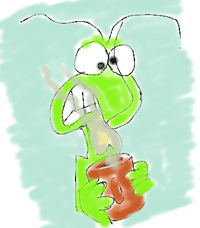
I'm currently writing the script of a new episode of our cartoon series. And it is perhaps one of the most exciting and interesting types of cartoon episodes I have ever attempted to write. It is a comic opera ballet. I have to admit that for years I have wanted to do this type of cartoon but the situation never presented itself until now. I have long been influenced by the Chuck Jones opera cartoons, What's Opera Doc and The Rabbit of Seville. As I was saying I have long wanted to tackle this type of cartoon. It is a real learning experience on many levels. Normally writing a cartoon in script form is a large enough challenge when there is so much action and visual humor involved. But when you add in the additional dynamic of opera and music the challenge is greatly multiplied. Most times background music is for me an after thought but not in a cartoon opera. Now the really interesting aspect of this episode is I'm not really writing it as much as I'm witnessing it and just writing it down. It just seems to be happening inside my head as our troop of characters performs it. And the strong interaction of the music in the flow of the story is also there and I just need to document it. When I discussed this with my story writing partner he became very intrigued as to how I planned to communicate this all in just typed text. And I realized it was not going to be possible. He would never get the same feeling for his visuals although that isn't totally bad because his unique visual interpretations are part of the synergy of our collaboration. But I decided that the script would need many of the musical parts audibly included so that as it is read the importance of the musical influence could be communicated. Visually the characters in costume and some in drag creates a whole new perspective on their interactions and adding ballet dancing to the mix is visually very funny as well. This will certainly be a most difficult episode to produce but at least at this early stage of pre-visualization it is already shaping up to be a classic.
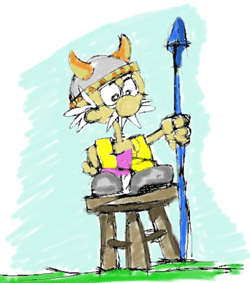
Speaking of classics, “What’s Opera Doc” was one of the most beloved of all Warner Brothers cartoons, it stars Elmer Fudd versus Bugs Bunny in a German opera, and features the great comic opera song "Kill the Wabbit!" Created by that magnificent team of Chuck Jones and Michael Maltese this cartoon parody of Wagnerian opera combines their usual off the wall style with a real appreciation of Opera. I love Elmer's role as the spear carrying Wabbit hunter and there is a particularly funny sequence with Bugs in drag as the warrior maiden Brunhilde. Elmer climbs to the top of a mountain to invoke magic to defeat the Wabbit and calls up the power of the weather, including winds, hurricanes, and the worst horror of all, smog, which is very Southern California in its humorous reference. It even has a “tragic” ending that almost sticks until Bugs as usual gets in the last word.
As I mentioned previously this cartoon is one of my favorites and I always wanted to do something in this style. Unfortunately there isn’t nearly enough written to explain the process of merging opera and cartoons so it will be a lot of trial and error to develop this episode. Thanks to some ideas I gathered from a great article "Animation and Music:You Can't Have One Without The Other" written by Tony Craig of the Disney Studios, I have a beginning foundation for where to start. Check back and I'll keep you posted how it's going.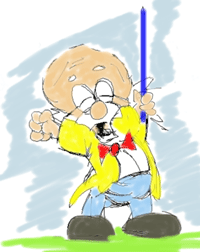
Because a Cartoon Moves Doesn't Mean It Connects
A lot of web cartoons are flat and lifeless, is it because they are created in Flash? Well, yes that is probably one reason. But it isn't inherently a flaw in Flash that causes this problem but rather its availability and ease of usage. We often tend to forget that without a production environment like Flash and a distribution platform like the Internet that tens of thousands of web cartoons would not even have ever been made. It has certainly opened up a communications medium to millions of people.
For all its shortcomings, Flash has enabled massive numbers of would be cartoon makers to be able to publish their work. This is not a bad thing but it does create a lot of poorly done cartoons along with some real diamonds too.
Moving objects around on a screen is not animation in the true sense of the word. It is motion. Animation actually means to give life, to impart that spark which connects with a viewer's imagination and emotions and transforms art.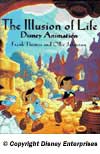
In order for a cartoonist to create life they must translate their own emotions into their art. It isn't a technology thing. In fact, if you think about it for a moment, technology is a tool and a barrier.
Traditionally, a cartoonist is story teller that uses graphical art as a vehicle. But a cartoonist is much more than just a graphical artist; we are also performing artists, and actors. We play many roles in our cartoons, one for each character. Traditionally actors use their bodies as the instrument of their performance. A cartoon director / animator uses their pencil. But the emotional connection has to be the same. For an actor movement of their body, their body language, must be developed if they are to be able to communicate emotions. For an animator their drawing skills must be developed if they are to be able to communicate their emotions.
It is a wonderful gift that Flash and the Internet bring to the cartoonist; they enable us to deliver content. But the content itself must come from the artist. The challenge is to discover our own voice and to translate our emotions via this relatively new medium.
Where do we begin? Well unfortunately for most web cartoonists the beginning is producing a cartoon. It would be like a person deciding that they wanted to be an actor and their first attempt to act is to write, produce and star in a three act play. Some truly gifted individuals might actually pull that off, but most actors would be more successful just trying to play a small part in a simple scene. The same is true for a new cartoonist; we must start small and develop our acting skills in small steps.
What's the first step for most beginning cartoonists? Well it should be to try to convincingly create life in an inanimate object. It doesn't have to be a complex object, in fact the simpler the better. It could be a letter from the alphabet or a ball, or a cube, or a sack of flour. But until you can make that simple object capable of translating your emotions to an audience you aren't really animating you are just making things move on the screen.
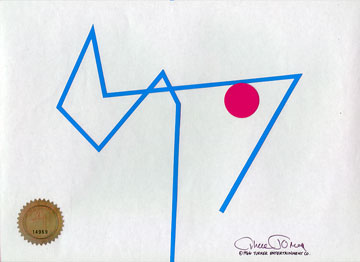
“The Dot and the Line", Chuck Jones’ award winning short, is an example of this ability to connect emotionally thru the simplest of inanimate objects. This is an amazing animated cartoon that took a brilliant story from a book and brought it to life. This is a great piece to study for anyone wanting to understand the creative power of skilled animators.
I see a lot of discussions in Internet forum sites where people get all excited about a still picture that someone drew or painted. Or they argue endlessly about doing frame by frame animation and how Flash “tweens” don't look good. Or they rant and rave on about having or not having a graphics tablet. But there seems to be a huge void in discussion about actually creating work that connects with an audience or that conveys feelings.
It seems that many people confuse how realistic something looks or how close something looks to live action with good animation. Let's face it; realism and realistic movement in and of themselves are important to simulation but not animation. If you are trying to simulate the real world this may be an important objective but most simulations may be informative but aren't usually classified as entertaining.
Now I will admit that in a strict definition of animation that it doesn't have to be entertaining. But for the focus of this article we are assuming that most people want to be entertained when they watch a cartoon. Motion graphics and flying titles may be interesting or they may catch your eye, or at least add something extra to a web site besides static pictures and text but they hardly rank as entertaining or capable of emotionally connecting with anyone.
Most artwork is representational. It is analogous to something but it is by no means realistic. And the same is true in animation, characters and their movement is representational. Too many people get so tied up in the look, that they miss the point.
If your animation is believable then you are connecting with an audience. But believable has nothing to do with realistic. Believable means that the viewer relates to what you are presenting with their own experiences and feelings and they are relaxing their perception of reality enough to include your representation. You have made a connection and your work is communicating feelings.
Character personality is an absolute requirement in making an emotional connection. So perhaps we should explore, what is personality? I guess our usual definition of personality is that which makes an individual seem unique and interesting. It is a differentiation between how we perceive others. At least that's the uniqueness part but what about the interesting part? Things can be different without always being interesting so perhaps that is a key to what really drives a sense of personality. To be interesting something must attract our interest, awaken our curiosity or at least make us take notice. So what drives our interests?
We are usually interested in things that we find important that we can identify with and to which we can relate. So a character's personality must have aspects with which we can identify. They might be our own characteristic or the characteristics we aspire to possess or the characteristics we try to suppress.

Again, Chuck Jones the great cartoon director talks a lot about characters and personality in the books that he wrote. If you have never read "Chuck Amuck" or "Chuck Reducks" you really are missing a treat. Not only was Chuck a great cartoon creator he was as funny in person as his creations were on the screen. And he was a most insightful writer about the subject of cartoon making. His books are master works of intellectual insight and treasures of knowledge for future generations of creators.
As I was saying Chuck Jones often remarked that he worked with cartoon characters that were personalities not drawings. They acted and reacted as personalities. They could play a role in a cartoon but they also played it true to their own nature. Chuck always said that Bugs Bunny had characteristics to which he as a cartoonist aspired, where as Daffy Duck said and did what most of us think although we don't always say or do. There is a lot of insight in those descriptions.
Think about a character like Pepe LePew. He isn't funny or interesting because he's a skunk. He's funny and interesting because he thinks and acts like he is this great lover. He is totally oblivious to his short comings and can only see himself in the light of his own self view certainly not as he is viewed by the world. That's a real personality. We all know people just like that. Maybe we even have a little Pepe in ourselves.
So the secret to creating living thinking characters is not how funny you draw them or how great you make them move, it is how they act and react. Until your characters evolve in your mind from being characters you created into characters who's adventures you are chronicling they aren't connecting with you and they won't connect with your audience.
Cartoon Production Deductions
I use to do all my storyboards by sketching panels on 3x5" blank white index cards and then I would lay out the sequences by sticking the cards up on big sheets of fiber board material. (Actually I use to use the back s of some surplus 2X4' acoustic ceiling tiles for my mounting boards). I would also put dialogue and other notes on strips of paper thumb tacked under the index cards. It worked Ok but was not really practical in today's world of virtual studios. For example at TGRS we actually work as collaborators in many different geographic locations. So when we are working on a board and want to show it for input we have to use the Internet and having the board converted to digital form works really well.
I once actually tried video taping the physical board walkthrough and converting the DV tape to QuickTime for streaming over the net, but I finally decided that using something with a timeline, like Flash, supports much better communication and it is much easier to use for making revisions. We still do most of our panel sketching on paper and then scan them into the computer and import them into Flash, but then we can also animate sections of the storyboards to create sort of an animatic because everything is digital at that point.
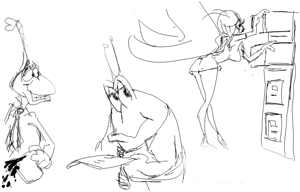
Our Flash storyboards get really pretty detailed because it becomes so easy to add scenes or shots and we not only put in any written dialogue but also we add SFX and Camera move notes, the Foley requirements, and even ideas for the musical scoring. I use to think it was a lot of extra work, but this is really a great way to plan a cartoon and work through a lot of the problems. It actually seems to save a lot of work on the backend with fewer "dead ends" and "deleted scenes". Also a lot of storyboards prove out that what seemed to be a good concept just wasn't that good or that funny and wasn't worth continuing. More often though the boards show weaknesses in a story or the presentation and they give you a place to make improvements before you get too invested in any one concept. The trick is to remember not to approach it like finished art but more gestural because the faster and easer it is to make the less you will mind making chances.
Certainly doing extra work in the production of a film should be avoided. After all animation is extremely labor intensive already. Which brings us to the question, are animatics extra work? Are they potentially a powerful tool or step in the process, that can be utilized to actually save you time and effort later in the production by letting you work out or adjust details, solve problems, and fine tune your vision of the final film prior to committing time and labor to efforts that will end up on the "cutting room" floor? We think they are well worth the time because there are sequences that just can’t be visualized and worked out with snapshot style boards only. Sometimes a rough animation version is so much better. And actually seeing boards with actual scratch dialog, SFX and music is really useful in determining if your story ideas will really work. I'll save the discussion of cartoon story flow and rhythms for a future posting.
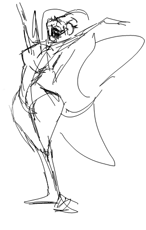
I'm one of those people who educators classify as a visual learner, I think most artist are. I probably watched too much TV as a kid. Anyway, I like to visualize a story in my head and then I want to move to the visuals pretty fast during the writing stage, but I usually write a initial script first because I don’t have time to do the boards by myself these days, plus it helps to get more than one person doing the visualizations. I start with a situation, but actually, I start with a cast of characters. Once I have a good picture in my mind of the characters, really also understanding their complex personalities, I can start to visualize them in situations and then the stories start to flow. It is more like watching them and reporting their adventures then it is like writing a script. It probably stems back to the way I played as a kid. All the kids in the neighborhood would pick a character role and then we would act out stories; sort of improvisations.
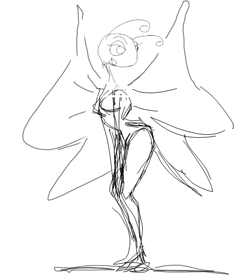
At TGRS we rarely ever just write, or draw up a story idea and then just say “great, now we can make this cartoon ". It usually goes through many revisions. At first we really like the idea, and then usually after some time passing, we find places to change things. Then after some rework, we get frustrated with the story and have to put it away. I suppose that at any given time we have several episodes that are sitting around in some phase of "I'm tired of working on that one right now" or “This needs to sit until we can approach it again fresh later”. It's not that they aren't good ideas or at least potentially good ideas, but when we work on things for awhile, really intensely focused, we get too close to them and just need to distance ourselves and then come back for a second or third pass. Personally, I do the same thing when I'm animating a sequence, I never can just leave my work being satisfied after only one pass. It's a little like cooking, it just isn't ready until it's ready so there is no sense trying to rush.
We Don't Need No Stink'n Storyboards !
It is amazing to me the number of aspiring artists who want to make cartoons, thanks to the easy access to programs like Flash or Toon Boom Studio, that have the mistaken impression that story boarding is an unnecessary waste of time, unless maybe if you are part of a big studio. Nothing could be farther from the truth.
Not only is the creation of a story board an important part of writing cartoons, it is also one of the pure joys of the process. Now anyone who has ever been involved in producing a cartoon, without regard to its length, has painful, perhaps repressed, memories of what a long tedious, extended, "like watching grass grow" process it can be. In fact, I would venture to say, that more animated cartoon projects fail to be completed because of the overwhelming loss of momentum that results from how long it really takes to produce a finished product then for almost any other reason. That's right, just plain loss of interest, boredom, "off to their next great conquest", "this has gotten old" loss of momentum. If you have never been there, the secret is out of the bag, cartoon production is like any significant project. It starts off with great excitement and it slows to a crawl with the execution. And most projects just plain run out of gas in the middle, if not sooner. So, what can you do to avoid the cartoon maker’s blues?
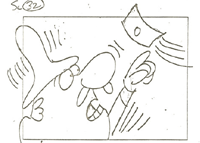
The first step is to understand and realize that the joy is in the journey not the destination, so you need to mentally be prepared and have the right attitude. It takes a lot more persistence than creativity to be successful. But taking pleasure in the work and all of its many phases helps to keep you focused through the long process. The writing phase which includes story boarding and basic animatic production is not only one of the most creatively important phases, like I said, it is fun.
Let's explore some of the many values to producing a storyboard and an animatic along with a script. The more you write, the easier it gets, and over time the more "visual" your scripts will become. But part of that results from the relatively fast conversion of the written word into actual pictures, the story board. Cartoon writing is iterative, and the steps usually go from written script to initial boards to a combination of revised scripts and boards back and forth until a solid story emerges. Now we find that a combination story board / animatic helps to keep it fresh and alive as well as giving us a sense of "is this working". The story board and the animatic not only act as a quick realization of the initial vision, they also provide a solid reminder of where you are going, along the way, which is comforting during the long production process.
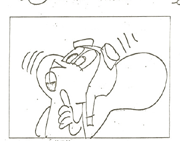
You’re asking "but if I'm a small independent producer do I need this step when I don't have to communicate my vision to others?" Hey, I didn't even mention the story board as a collaboration tool, which is one of its primary purposes. If you are collaborating, you have to have a visual roadmap to use to manage the planning process and to keep everyone on track. But that's just the obvious reason for a story board. The less obvious reasons are the ones I'm discussing here, which are its importance as a reminder of what this long project is all about, and secondly as a safeguard that you don't start too far down the long production road with weak content. It's too much work just to create a really good film, so you sure don't want to do all that and wind up with a "yawn".
With today’s computers and software technology it seems that many aspiring independent producers get so tangled up in the applications that they forget that the delivery of entertaining and interesting content is their goal. Cartoon making is a visual medium but just because it moves doesn’t make it entertaining. The story, the presentation, what I often refer to as the content, is the part that viewers want most. There is a massive glut of visual movement that is passed off as animated cartoons. But to get your work noticed and differentiated and to build an audience you have to be very entertaining. So a solid lesson to be learned is that the pre-production phase is not to be left until your vision is refined into a very entertaining product. What’s the rush? If you rush through or skip past this important work, you may kid yourself that you are producing something, but there is plenty of noise out there already and you are probably just adding to the din.
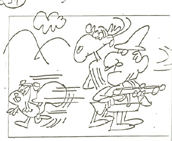
If your script and storyboards aren’t entertaining why would you think that your end product will improve with age? Most creators know that the zest and energy that goes into the boards is often reduced not improved during production. You can’t count on inspired changes after the fact. Many professionals actually hate to turn loose of the script and the boards because they know that the “watering” down often follows. So even if you have this great idea in your head and you are working by yourself, put it down on paper and visualize it while it is clear. First of all it probably isn’t clear and second of all it’s a long road and you are going to need a solid plan and a well developed vision or you are going to get lost along the way. Oh and did I mention before it’s a lot of fun. If your work isn’t entertaining to you what makes you think it will be to other people. We roll on the floor watching our boards come to life. You want and need that reinforcement because later during the long process you are going to see this stuff over and over endlessly and it won’t be very fresh or new for long. After a while you will start to question if it is entertaining because it becomes so familiar. You need those memories of how funny it was when you did the boards to keep you grounded and confident. Those stink’n story boards and animatics are not obsolete or a waste of time, they are the best technique invented for starting and finishing a cartoon project.
These "Suits" Are Diving Me Nuts
I think one of the all time funniest cartoons was The Adventures of Rocky and Bullwinkle. And thanks to the re-mastering of these classic cartoons on DVD they are readily available to enjoy again. They were never great art from a quality of the drawings or the animation, but they certainly proved that great content trumps style every time.
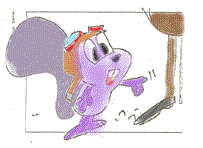
It was more by accident than by design that these cartoons ended up with their almost amateur art style. In the late 1950’s and early 1960’s, TV cartoons were still very new and totally sponsor driven. Advertising agencies and Cereal companies controlled the market, and being a producer meant following their rules or not getting into the game. Things have changed significantly today, now the big media companies make the rules, different masters, same game.
When Jay Ward was trying to pitch his new ideas, he was often frustrated by the “suits” from Madison Avenue. Eventually, he sold Rocky and His Friends, but he had to pay a dear price. His price per episode was way too cheap, and when he tried to make adjustments he was forced to move his production to a new studio located in Mexico and backed by the sponsors. Gamma Studios was made up of mostly inexperienced and low paid local artists who were managed by an ever changing guard of imported Hollywood trained supervisors. And this was not in today’s virtual world of the Internet and video conferencing and easy global collaboration, so it is no wonder the results were less than great, art wise.
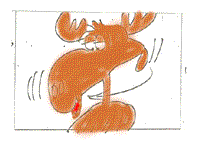
But in retrospect there was probably a silver lining to that cloud. They had the handicap of their production constraints and their low price per episode so they had to sacrifice their desire for high production values and that inspired them to make sure the scripts where really great as a means of artistic compensation. Additionally, the frustration of their situation as peasants in a “suit” driven hierarchy made them all the more irreverent in their desire to push the envelope of subjects to satirize. The results are history. Long before the Simpsons or South Park, Ward Productions was blazing the trail for smart multi-generational humor that was really funny on many different levels.
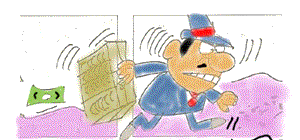
There are many lessons to be learned from their experiences. But perhaps the most important lesson is that limitations and constraints aren’t to be feared or avoided, but rather they become the catalysts for better work. So the next time you are feeling frustrated at how difficult it is to create with all the outside interferences that are inevitable in media production, just remember that those frustrations can be turned into increased creativity.
Origins and Such Things
It sure is hard to find time these days to post here at Between the Frames. I really shouldn’t complain, as being busy and productive are good things. We were somewhat kicking back last night during one of our usual nightly story sessions and during the conversation the topic wandered into some historical territory.
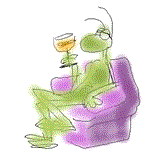
We were discussing a new character named Vidalia. Needless to say Vidalia is a very attractive female in the style of a Jessica Rabbit or a Lola Bunny sort of way. The name was well accepted but the curious question arose "what was its origin?" Vidalia is a town in South Georgia, USA. It is famous for the sweetest, best tasting onions and a great place to visit or live. So what better name for a cartoon heart throb?
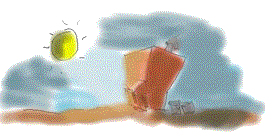
Everyone loved the story of where we got that name, and so the next question was from "where did our studio’s name, TallGrassRadio, arise?" It’s a long story, but the short version goes back to a 1980's comic strip which we created called Greenbrier. It followed the adventures of a group of precocious house plants. Now when we were creating that comic strip, we were trying to brainstorm "how would house plants in a human world be independent and able to make a living?" And the answer was, they worked in talk radio. No one really knows the people behind radio voices, so they could easily be a bunch of talented house plants. Of course we needed a fictitious radio station and we invented KDRT (K – DIRT). As things evolved, the station evolved and went beyond talk shows to performing Radio Theater and it started being known as the TallGrassRadio Theater. We don’t do much with the original strip anymore, but we always liked the name, so our cartoon studio became TallGrassRadio Studios. We still find a lot of our best material crawling around in those weeds in the garden.




















